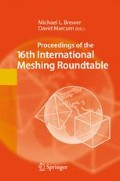Abstract
This paper introduces a new approach to automatic mesh generation over composite geometry. This approach is based on an adaptation of advancing front mesh generation techniques over curved surfaces, and its main features are: elements are generated directly over multiple parametric surfaces: advancing front propagation is adapted through the extension to composite geometry of propagation direction, propagation length, and target point concepts, each mesh entity is associated with sets of images in each reference entity of the composite geometry, the intersection tests between segments are performed in the parametric domain of their images.
Access this chapter
Tax calculation will be finalised at checkout
Purchases are for personal use only
Preview
Unable to display preview. Download preview PDF.
References
Halpern, M., Industrial requirements and practices in finite element meshing: a survey of trends, in 6th International Meshing Roundtable. 1997. p. 399–1997.
S. Dey, S.S. Mark, and K.G. Marcel, Elimination of the Adverse Effects of Small Model Features by the Local Modification of Automatically Generated Meshes. Engineering with Computers, 1995. 13(3): p. 134–152.
Shephard, M.S., M.W. Beall, and R.M.O. Bara, Revisiting the Elimination of the Adverse Effects of Small Model Features in Automatically Generated Meshes, in 7th International Meshing Roundtable. 1998. p. 119-132.
Mark, W.B., W. Joe, and S.S. Mark, Accessing CAD Geometry For Mesh Generation, in Proceedings of 12th International Meshing Roundtable, Sandia National Laboratories. 2003.
L. Fine, L. Remondini, and J.C. Leon, Automated generation of FEA models through idealization operators. International Journal for Numerical Methods in Engineering, 2000. 49(1): p. 83–108.
S. Venkataraman, M. Sohoni, and R. Rajadhyaksha, Removal of blends from boundary representation models, in Proceedings of the seventh ACM symposium on Solid modeling and applications. 2002. p. 83–94.
S. Venkataraman, M. Sohoni, and G. Elber, Blend recognition algorithm and applications, in Proceedings of the sixth ACM symposium on Solid modeling and applications. 2001. p. 99–108.
S. Venkataraman and M. Sohoni, Reconstruction of feature volumes and feature suppression, in Proceedings of the seventh ACM symposium on Solid modeling and applications. 2002. p. 60–71.
K. Y. Lee, et al., A small feature suppression/unsuppression system for preparing B-rep models for analysis, in SPM ’05: Proceedings of the 2005 ACM symposium on Solid and physical modeling. 2005: New York, NY, USA. p. 113–124.
A. Sheffer, Model simplification for meshing using face clustering. Computer Aided Design, 2001. 33(13): p. 925–934.
K. Inoue, et al., Clustering a Large Number of Faces For 2-Dimensional Mesh Generation, in 8th International Meshing Roundtable. 1999. p. 281-292.
G. Foucault, et al., A Topological Model for the Representation of Meshing Constraints in the Context of Finite Element Analysis, in Proceedings of ASME 2006 International Design Engineering Technical Conferences and Computers and Information in Engineering Conference. 2006: Philadephia, USA.
DL. Marcum, J.G. Unstructured Surface Grid Generation Using Global Mapping and Physical Space Approximation. in 8th International Meshing Roundtable. 1999.
F. Noel, Global parameterization of a topological surface defined as a collection of trimmed bi-parametric patches: Application to automatic mesh construction. International Journal for Numerical Methods in Engineering, 2002. 54(7): p. 965–986.
S. H. Lo and T. S. Lau, Mesh generation over curved surfaces with explicit control on discretization error. Engineering Computations, 1998. 15(3): p. 357–373.
G Foucault, J-C Cuillière, V François, J-C Léon, R Maranzana,, Towards CAD models automatic simplification for finite element analysis, in 2nd World Congress of Design and Modelling of Mechanical Systems. 2007: Monastir.
J-C Cuilliere, An adaptative method for the automatic triangulation of 3D parametric surfaces. Computer Aided Design, 1998. 30: p. 139–149.
J-C Cuilliere, Direct method for the automatic discretization of 3D parametric curves. Computer Aided Design, 1997. 29(9): p. 639 - 647.
Author information
Authors and Affiliations
Editor information
Editors and Affiliations
Rights and permissions
Copyright information
© 2008 Springer-Verlag Berlin Heidelberg
About this paper
Cite this paper
Foucault, G., Cuillière, JC., François, V., Léon, JC., Maranzana, R. (2008). An Extension of the Advancing Front Method to Composite Geometry. In: Brewer, M.L., Marcum, D. (eds) Proceedings of the 16th International Meshing Roundtable. Springer, Berlin, Heidelberg. https://doi.org/10.1007/978-3-540-75103-8_17
Download citation
DOI: https://doi.org/10.1007/978-3-540-75103-8_17
Publisher Name: Springer, Berlin, Heidelberg
Print ISBN: 978-3-540-75102-1
Online ISBN: 978-3-540-75103-8
eBook Packages: EngineeringEngineering (R0)

